Acropora corals are among the most popular species in the hobby, with their intricate structures and vibrant colors captivating aquarists worldwide. However, achieving optimal growth and coloration requires more than just good water chemistry; lighting plays a crucial role in the health and vitality of Acropora colonies. In this article, we’ll explore the top lighting techniques for promoting healthy Acropora growth, including spectral requirements, intensity, and duration.
Understanding Acropora Lighting Requirements
Before we dive into specific lighting techniques, let’s first take a closer look at the lighting needs of Acropora corals. As photosynthetic organisms, corals rely on light energy to produce food and grow. However, not all light is created equal; corals require specific wavelengths and intensities to thrive. That is why in this blog post we are going to break down the lighting set up we use and why we chose to use this set up. You can also check out our full lighting blog with an in-depth breakdown of schedules and setup.
Spectral Requirements
Acropora corals require a broad spectrum of light, with wavelengths ranging from 400 to 700 nanometers (nm). This range includes both blue and red light, which are essential for photosynthesis and growth. In addition, Acropora corals require a moderate amount of green light to support their pigments’ fluorescence.
Intensity
Intensity is another critical factor in Acropora lighting. Generally, Acropora corals require high-intensity lighting, with recommended PAR (Photosynthetically Active Radiation) levels of 200-400 micromoles per square meter per second (umol/m2/s). This high-intensity lighting helps to promote healthy growth, coloration, and fluorescence.
Duration
Finally, the duration of lighting is also crucial for Acropora corals. In the wild, Acropora colonies are exposed to natural light cycles, with periods of bright sunlight followed by darkness. In a reef aquarium setting, it’s essential to replicate this natural cycle. Generally, Acropora corals require 8-12 hours of bright light, followed by 12-16 hours of darkness.
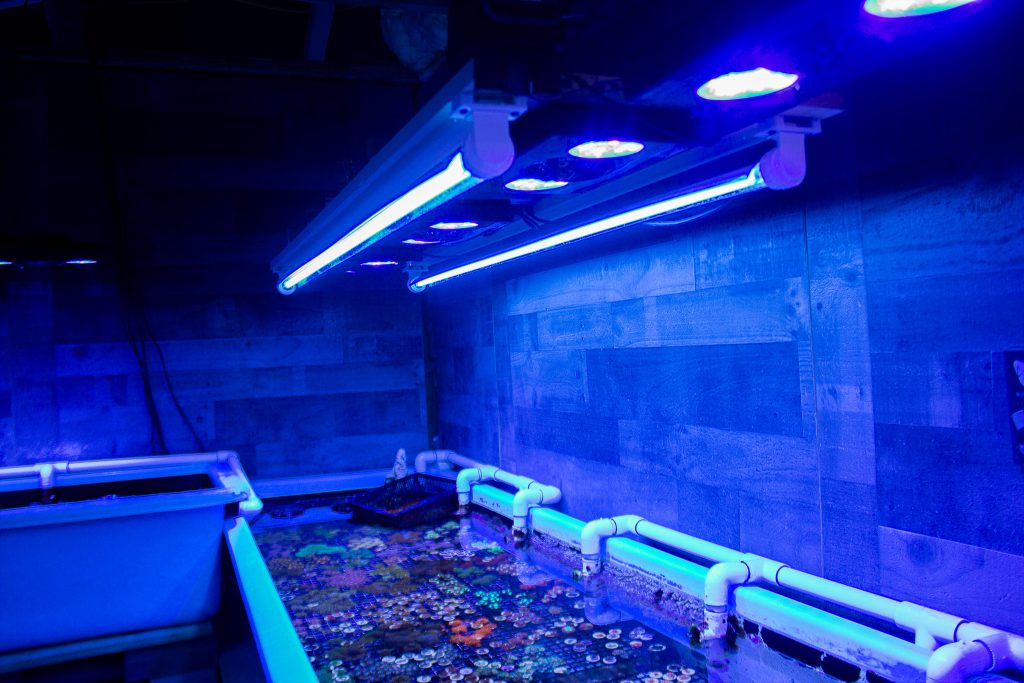
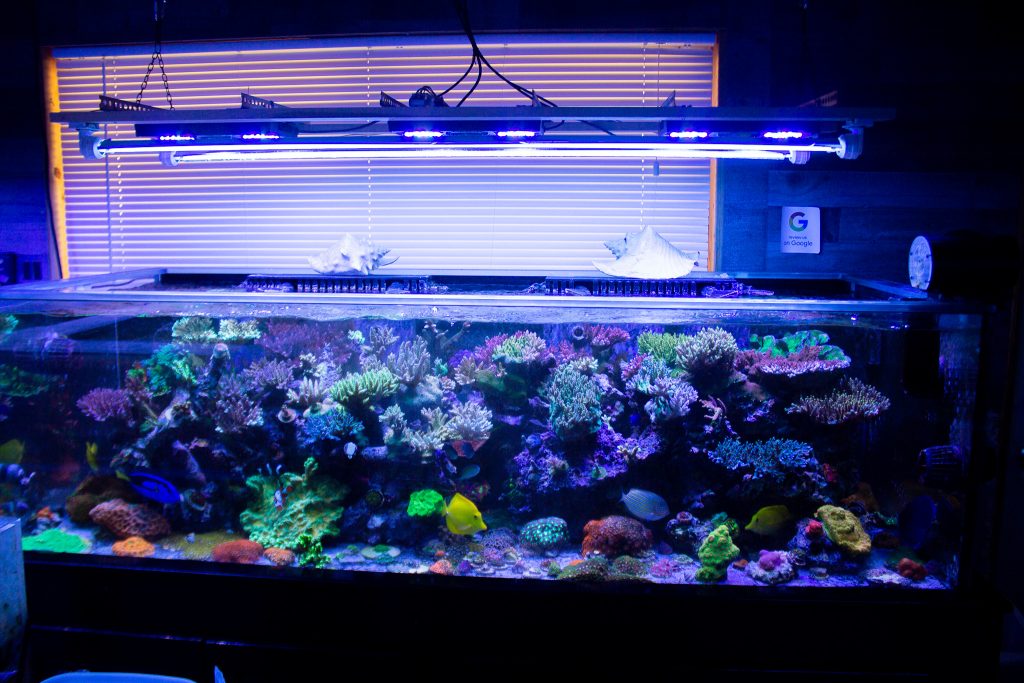
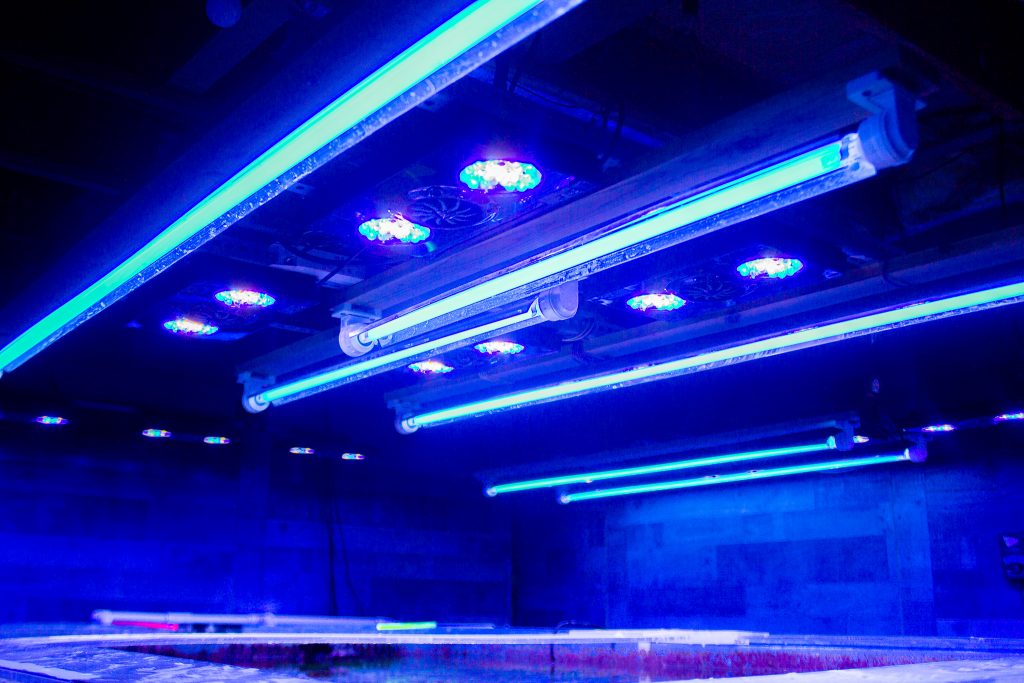
Top Lighting Techniques for Promoting Healthy Acropora Growth
Now that we understand the lighting requirements for Acropora corals let’s dive into the top lighting techniques for promoting healthy growth.
T5 Lighting
T5 lighting is a popular choice among reef aquarists, and for good reason. These fluorescent lights emit a broad spectrum of light, including blue, red, and green wavelengths, making them ideal for Acropora corals. Additionally, T5 lights can be easily adjusted to achieve the recommended PAR levels, making it easy to dial in the perfect lighting for your Acropora collection. We personally feel like T5s have lead to our success with the best coloration and growth in our Acros.
LED Lighting
LED lighting is another popular option for reef aquariums, and for good reason. These lights offer a high degree of control over spectral output and intensity, allowing for precise tuning to the needs of your Acropora corals. Additionally, LED lights are energy-efficient and long-lasting, making them a cost-effective lighting solution for your reef aquarium.
Metal Halide Lighting
While metal halide lighting has fallen out of favor in recent years, it remains an effective lighting option for Acropora corals. These lights emit a high-intensity, broad spectrum of light, making them ideal for promoting healthy growth and coloration in Acropora colonies. However, metal halide lights can be expensive to operate and require a cooling system to prevent overheating.
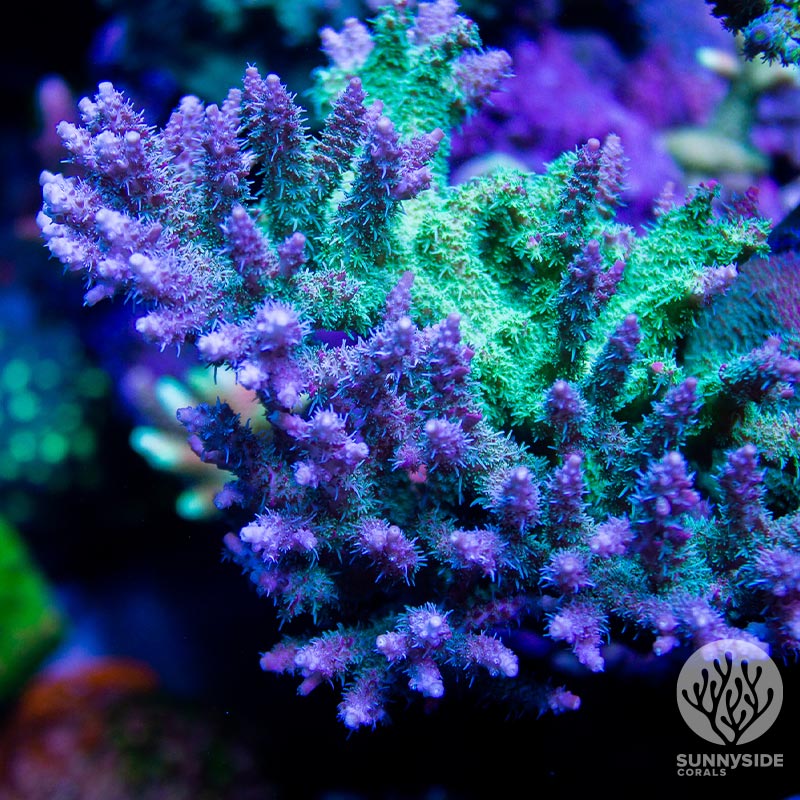
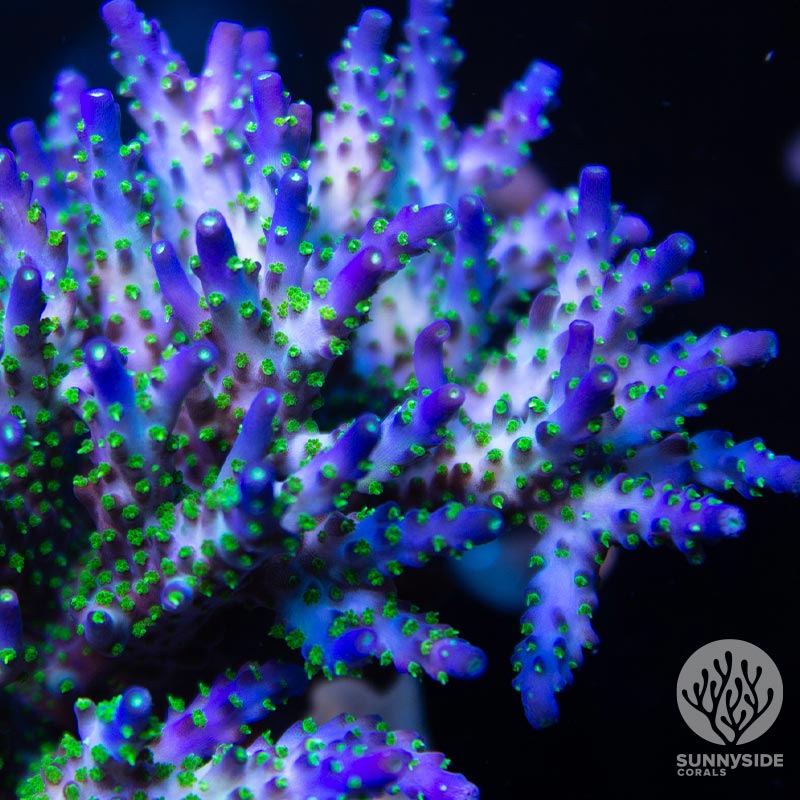
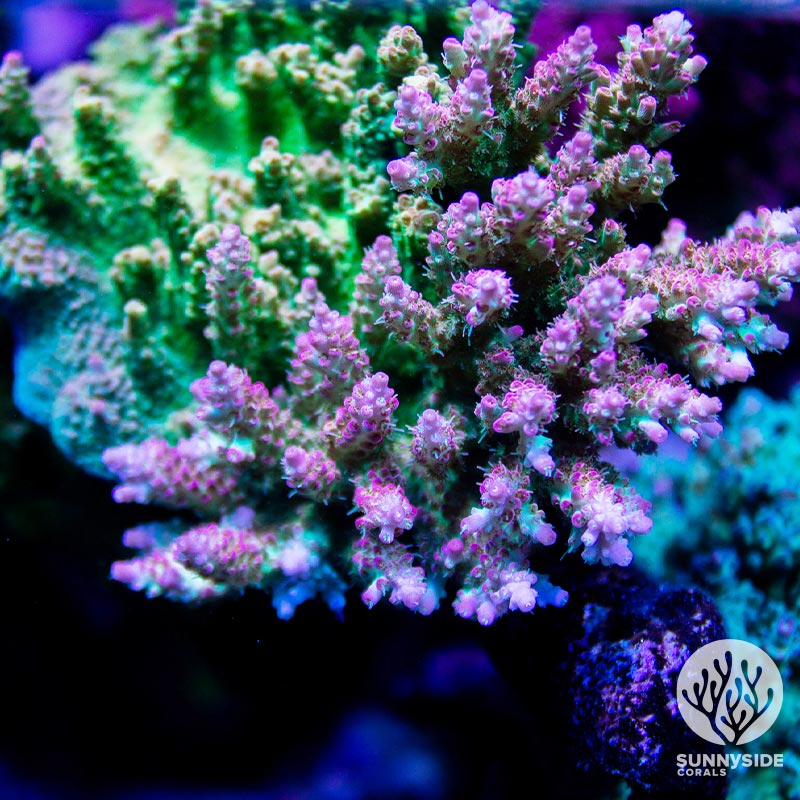
Our Acropora Lighting
Over the years we have tried and tested a wide variety of different types and have ultimately chosen to use a Radion and T-5 combo. We use Radion gen 3s and 4s for the most part but still run a few gen 2s. We use the ATI Blue Plus Bulbs with our T-5s. We found that by running a combination of Radions and T-5s we have the best success with coloration and growth with our corals, especially Acropora. If you want to successfully grow lots of Acropora this is the setup that we recommend. However, if you only want to grow mainly LPS and Softy Corals with only a few acros, you can be successful with just running Radions and no T-5s. The problem with only running radions for an acro heavy tank is that you run into issues with the amount of light spread. Your acros will appear colorful on top but dull and brown on the underside. This will affect the acro as it grows into a colony as the base will not receive enough light and may affect growth. The way to combat that is by either having a higher concentration of Radions or adding a T-5 light. Often times people favor adding T-5s because they are known to perform well but also you can save a lot of money because T-5s are a fraction of the price of radion lights.
For a more detailed dive into our lighting set up check out our full aquarium lighting blog post for our exact schedule and set up.
Acropora Placement
Placement is key when it comes to lighting exposure to your corals. The higher up your coral is placed in your system, the more light it receives and this can have a significant impact on their growth and overall health. Here are some general guidelines for placing different types of Acropora corals in your tank:
Branching Acropora Corals:
- Branching Acropora corals, such as Acropora digitifera and Acropora tenuis, have thin, delicate branches that grow in a bush-like pattern. These corals prefer high light conditions and should be placed in areas of the tank with high PAR levels. They also require strong water flow to bring nutrients to their delicate branches. Therefore, it is recommended to place these corals in the upper to middle areas of the tank, where they can receive strong light and water flow.
Staghorn Acropora Corals:
- Staghorn Acropora corals, such as Acropora echinata, have thick branches that grow in a staghorn-like pattern. These corals also prefer high light conditions but can tolerate slightly lower PAR levels compared to branching Acropora corals. They require moderate to strong water flow to bring nutrients to their branches. Therefore, it is recommended to place these corals in the middle to lower areas of the tank, where they can receive moderate light and water flow.
Plating Acropora Corals:
- Plating Acropora corals, such as Acropora millepora and Acropora valida, have thin, plate-like structures that grow in a horizontal direction. These corals prefer moderate to high light conditions and moderate water flow. They should be placed in areas of the tank with moderate PAR levels and moderate water flow. It is recommended to place them on the bottom of the tank, where they can receive moderate light and water flow.
Table Acropora Corals:
- Table Acropora corals, such as Acropora nobilis, have thick, plate-like structures that grow in a horizontal direction, forming a table-like shape. These corals prefer moderate to high light conditions and moderate water flow. They should be placed in areas of the tank with moderate PAR levels and moderate water flow. It is recommended to place them on the bottom of the tank, where they can receive moderate light and water flow.
It is important to note that these are general guidelines, and the placement of your Acropora corals may vary depending on the individual needs of the corals in your tank. It is always recommended to monitor the growth and health of your corals and adjust their placement accordingly. Additionally, it is important to ensure that your corals have enough space between them to prevent overcrowding, which can lead to stunted growth and poor health.
FAQ Section
What is the best light for Acropora?
The best light for Acropora corals is one that provides a broad spectrum of light, including blue, red, and green wavelengths. This light should also be high-intensity, with recommended PAR levels of 200-400 umol/m2/s.
How much light does Acropora need?
Acropora corals require 8-12 hours of bright light, followed by 12-16 hours of darkness.
Do Acropora need white light?
Acropora corals do not require white light specifically, but they do require a broad spectrum of light that includes blue, red, and green wavelengths.
What are ideal Acropora parameters?
The ideal parameters for Acropora corals include a temperature range of 75-82°F (24-28°C), salinity levels of 1.024-1.026, and calcium levels of 400-450 ppm. Additionally, it’s essential to maintain stable water chemistry and avoid large swings in parameters.
In conclusion, achieving healthy and vibrant Acropora colonies requires more than just good water chemistry. Proper lighting is crucial for promoting growth, coloration, and fluorescence. By understanding the lighting requirements of Acropora corals and using the top lighting techniques outlined in this article, you can create a thriving and beautiful reef aquarium that will be the envy of all your friends.
